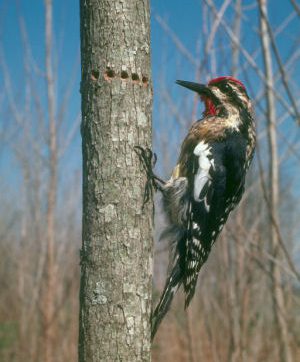
by Daniel J. Leonard | Feb 3, 2017
Have you noticed strange rings of pencil-sized holes on the trunks of certain trees in your landscape recently? If so, take heart that these holes are not emanating from an infestation of destructive insects but rather from a perfectly native, rather attractive migratory woodpecker, the Yellow-Bellied Sapsucker (Syphrapicus varius)!
The Sapsucker is a smallish bird with a chisel-like bill, easily distinguishable by bold black and white face stripes and a conspicuous bright-red crown and throat. If you have any problem identifying it by its features, look to its migration pattern, the Yellow-Bellied Sapsucker overwinters in mild winter areas of the Americas (like Florida’s Panhandle) and causes damage during this period (roughly December through March). If you notice a bird wreaking havoc on your backyard flora this afternoon, it is likely a Yellow-Bellied Sapsucker!
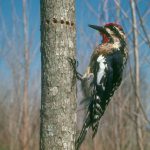
Yellow-bellied sapsucker (male) on pecan
James Solomon, USDA Forest Service, Bugwood.org
Like other members of its family, this woodpecker makes a living by “pecking” holes in trunks of trees and small shrubs about chest-high from the ground and feeds on sap and the occasional insect drawn to the sap. Fortunately, the damage is not usually harmful to the tree except in severe cases where the trunk may be girdled or secondary infection occurs from pests/diseases entering the tree through the holes. Unfortunately for Florida gardeners, this little bird has preferences in which trees it attacks, the majority of which are favorite landscape plants. For example, heavy feeding has been observed, both anecdotally by the author and more scientifically by researchers and birding enthusiasts, on Red Maple, Pecan, Chinese Elm, American Holly, Pine and Live Oak. They also really seem to enjoy any soft-wooded shrub limbed-up in a treelike form like Waxmyrtle, Viburnum and Dahoon Holly. Talk about frustrating!
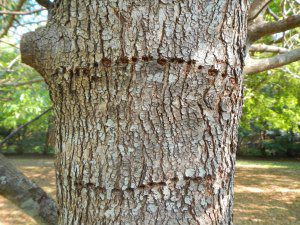
Sapsucker damage in a tree trunk.
Photo courtesy of Mississippi State Extension.
After learning that Sapsucker damage is not usually harmful, most homeowners opt to not control the birds’ feeding. However, if the aesthetic damage is not acceptable in your landscape, there are a few semi-effective control options and a host of other, less-effective home remedies. Wrapping the trunks of favored species with a loose, thick material such as burlap or felt is the preferred method of many ornamental nurseries and tree farms due to the material’s reusability and ease of removal after the migration has passed. Other commercial enterprises have had mixed success with hanging visually frightening CDs, pie plates and the like from low branches. Even less success has been seen with other homemade “cures” ranging from rubbing trunks of favored trees with Ivory soap to the use of sticky materials to deter perching. Shooting or trapping Yellow-Bellied Sapsuckers is not permitted as the birds are protected by state and federal wildlife law. As always, please contact your local UF / IFAS Extension office for advice and recommendations for other methods of discouraging unwanted bird visits!
Happy New Year and good gardening!
by Larry Williams | Jan 26, 2017
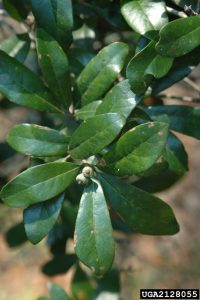
Live oak with immature acorns. Photo credit: Wendy VanDyke Evans, Bugwood.org.
Do you have more acorns than you know what to do with? When oaks produce loads of acorns, it sometimes is called a “mast” year. Do you remember the oak tree pollen and all those catkins that fell from oaks earlier in spring?
Catkins are the male flowers in oaks. Some people refer to them as tassels or worms. The airborne pollen from these catkins were part of the reproductive process in fertilizing the female oak flowers that ultimately resulted in all of these acorns. Oaks produce separate male and female flowers on the same tree. Female flowers in oaks are very small. You’d have to look very close to see them. Many oaks did well in their reproductive efforts this spring. Acorns are oak seeds. This entire process is part of the cycle of life.
There are theories about mast years, wildlife’s use of these acorns and what gardeners can expect next year as a result of this year’s abundant acorn crop. Timing of mast years is still a mystery. Numerous theories exist ranging from weather to geography to the life cycles of predators.
The most likely reason for high production seems to be weather-related. When oak trees have favorable weather at the time of oak flowering and good growing conditions, the mast seems to be increased.
But mast years happen irregularly, making it difficult to understand what causes a mast year. Heavy acorn production can occur twice in a row or it might be separated by several years or more. There’s no good way to predict it.
Mast years are important to wildlife, as acorns are an important food for many animal species. In low crop years, birthrate for some wildlife species, such as squirrels, will decline the following year. This also may involve increased competition for food and survival rates. The recent crop means that more young are likely to be produced by animals that forage for acorns.
Wildlife play a big role in forest regeneration. When acorns drop out of oaks, many animals help distribute these seeds. Squirrels can bury hundreds of acorns. Some of these acorns germinate and grow to become the next generation of oak trees. Some will be eaten by birds, bears, deer, rodents, including squirrels, and other wildlife. Rodents are in turn eaten by carnivores and deer browsing shapes which kinds of plants become established and survive. All those acorns have far-reaching impact on wildlife and our forests.
So, try to keep this in mind as you are fussing with all those acorns in your lawn and landscape this season.
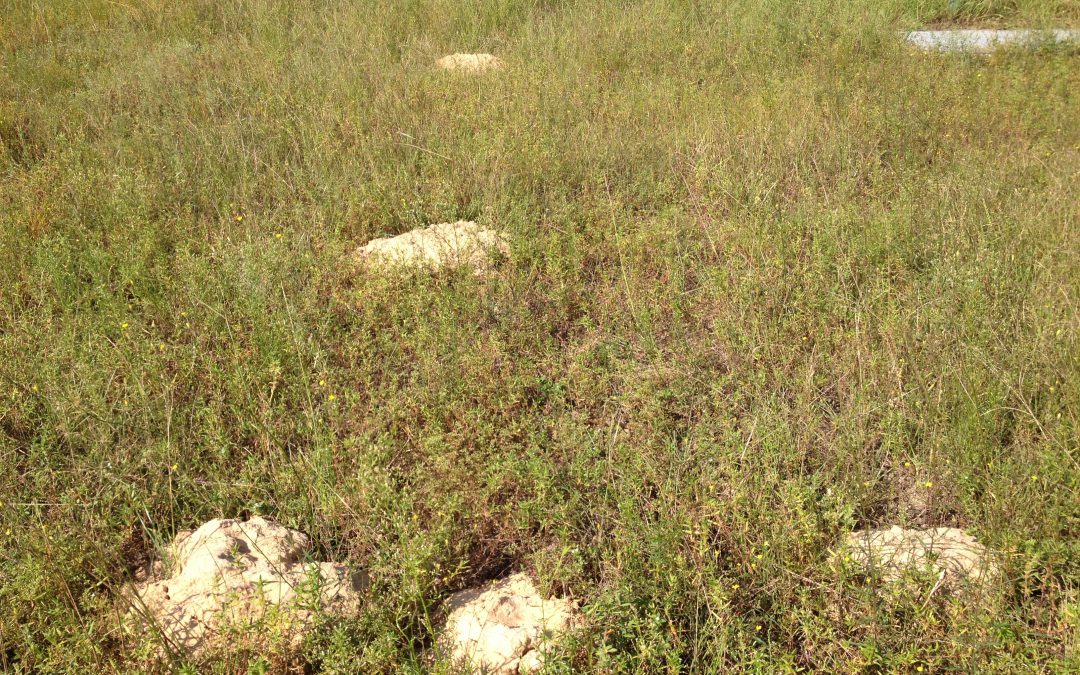
by Larry Williams | Sep 23, 2016
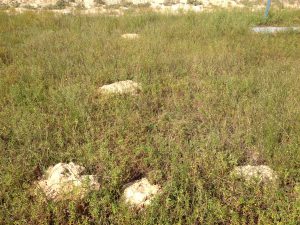
Mounds of sand made my pocket gopher along roadside. Photo Credit: Larry Williams
Pocket gopher is a furry animal known by many locals as “sandy mounder.” It was given this name because of the sandy mounds of excavated earth that the gopher pushes out of its underground burrows. The name sandy mounder, with time, became “salamander.” This animal is not a salamander at all. Salamanders are slimy amphibians shaped like lizards. Salamanders are often known as “spring lizards” in Florida.
To make this nomenclature problem more confusing, in some areas of Florida gopher means a certain burrowing tortoise – the gopher tortoise.
To simplify things keep in mind that in Florida “spring lizard” can mean “salamander” and “salamander” can mean “gopher” and “gopher” can mean “turtle.”
“Gopher” is a confusing word all over the country. Jeff Jackson, retired wildlife biologist with University of Georgia Extension says, “The Richardson’s ground squirrel of the west is called gopher. So is the thirteen lined ground squirrel of the Great Plains and Midwest. Moles are called gophers in many areas. And voles (certain short-tailed mice) are called gophers in some states.”
Jackson says there are six species of “sure enough, genuine pocket gophers in the United States.” Our pocket gopher is the Southeastern Pocket Gopher, found in north Florida, south Alabama and south Georgia.
The pocket gopher spends its time underground making tunnels and nests, eating roots and bearing and raising young. It may venture into residential areas where it can damage plants by feeding on tree and shrub roots or bulbs and tubers of various plants.
A pocket gopher can make fifty or more sandy mounds in a relatively short period of time. These mounds, which are normally four to six inches high and possibly a foot across, are what get homeowners’ attention. The mounds can “popup” overnight in lines or rows. They resemble fire ant mounds; however, they contain no ants.
The pocket gopher is a rodent that grows to about a foot long, has a short tail and weighs about half a pound. Its name comes from the large fur-lined pouches on the outside of its cheeks.
Even though they do contribute to the formation of soil and provide a food source for some predators, sometimes their damage may justify control measures.
Trapping is the most effective option. No chemical repellents are known to be effective. It’s illegal to use any poison to kill gophers. Vibrating devices have not been proven to repel gophers. A long held belief that Wrigley’s Juicy Fruit gum kills gophers by blocking their digestive system has been proven to be false.
A detailed fact sheet is available online at http://edis.ifas.ufl.edu/uw285.
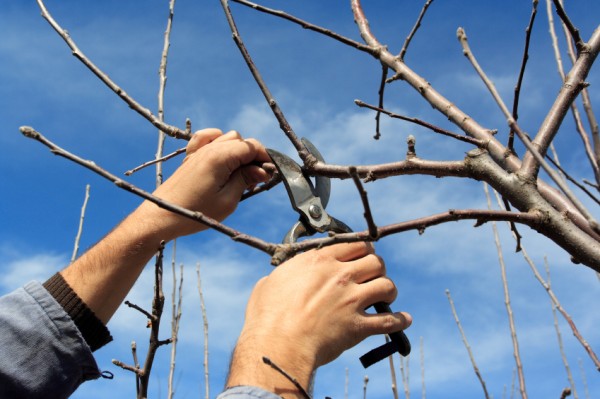
by Sheila Dunning | Dec 16, 2015
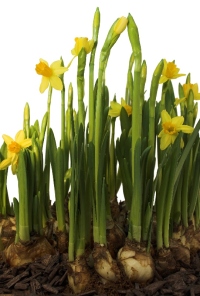
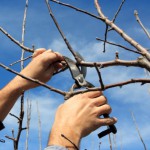 Though the calendar says December, the weather in Northwest Florida fluctuates between winter and spring temperatures. The nice days are wonderful opportunities to accomplish many of those outside landscape chores in preparation for spring. But, it is also a good time to start planning for next month’s colder temperatures. Since we don’t experience frozen soil, winter is the best time to transplant hardy trees and shrubs. Deciduous trees establish root systems more quickly while dormant; versus installing them in the spring with all their tender new leaves. Here are a few suggestions for tasks that can be performed this month:
Though the calendar says December, the weather in Northwest Florida fluctuates between winter and spring temperatures. The nice days are wonderful opportunities to accomplish many of those outside landscape chores in preparation for spring. But, it is also a good time to start planning for next month’s colder temperatures. Since we don’t experience frozen soil, winter is the best time to transplant hardy trees and shrubs. Deciduous trees establish root systems more quickly while dormant; versus installing them in the spring with all their tender new leaves. Here are a few suggestions for tasks that can be performed this month:
- Plant shade trees, fruit trees, and evergreen shrubs.
- Plant pre-chilled daffodil and narcissus bulbs (late December/early January).
- Do major re-shaping of shade trees, if needed, during the winter dormancy.
- Water live Christmas trees as needed and water holiday plants such as poinsettias as needed.
- Check houseplants for insect pests such as scale, mealy bugs, fungus gnats, whitefly and spider mites.
- Continue to mulch leaves from the lawn. Shred excess leaves and add to planting beds or compost pile.
- Replenish finished compost and mulch in planting beds, preferably before the first freeze.
- Switch sprinkler systems to ‘Manual’ mode for the balance of winter.
- Water thoroughly before a hard freeze to reduce plants’ chances of damage.
- Water lawn and all other plants once every three weeks or so, if supplemental rainfall is less than one inch in a three week period.
- Fertilize pansies and other winter annuals as needed.
- Protect tender plants from hard freezes.
- Be sure to clean, sharpen and repair all your garden and lawn tools. Now is also the best time to clean and have your power mower, edger and trimmer serviced.
- Be sure the mower blade is sharpened and balanced as well.
- Provide food and water to the area’s wintering birds.


by Carrie Stevenson | Sep 29, 2015

Cool Season Wildlife Food Plot. Photo by Jennifer Bearden, UF / IFAS
Many of us enhance our home landscaping with bird feeders, bird houses, bird baths and other items so that we can attract wildlife. To accomplish the same thing, many rural landowners plant wildlife food plots. While large landowners often plant several acres, food plots can work well in any sunny area and can be as small as an urban garden.
Food plot plants that do well in our area include clovers, millet, partridge pea, winter wheat, corn, sunflowers and legumes. Deer also like beggerweed and cowpeas.
If you decide to establish a wildlife food plot, you should manage it just like any other garden. The location should be sunny (a minimum of 50% sunshine is recommended) and plots often look better and wildlife will feel safer if you have a backdrop like a forest edge or tall hedgerow.
Just like any other garden, turn the soil with a garden plow or shovel and than smooth the seedbed. Seeding can be done by hand or with a handheld broadcast spreader.
Seeds should be covered lightly (1/4 to 1/2 inch in most cases) and watered as needed. In normal years watering won’t be needed, but if you get an extended dry spell you may want to give the plants additional water. Fertilizer is also recommended and will definitely give you more productivity. I have escaped that myself by growing clover in the winter for nitrogen and adding fireplace ashes to provide calcium (liming agent), potassium and phosphorus. If there is any doubt about what to apply, it is best to get a soil test and follow the recommendations for applying lime and fertilizer. Contact your local County Extension Office for more information.
I generally plant two crops in my wildlife garden–crimson clover in October (that beautiful clover you see in spring along the highways) and brown top millet in the spring after the clover dies back. I mow between seedings; this can work without tilling with some crops, if you keep the weeds under control. When I mow the millet it puts the seed on the ground and many ground feeding birds like doves move in to eat the seeds.
Speaking of gardens, the wildlife food plot makes a useful cover crop for your vegetable garden if you are taking a long vacation or just need a break for any other reason. You can also use the plants as green manure when you decide to put vegetables back in your garden.
It is always good to remember that when wildlife view your landscape, they don’t see pretty grass, flowers, shrubs and trees–they see habitat, good or bad. Food plots simply boil down to food and shelter for them.
To learn more about food for wildlife, consult this article on establishing and maintaining wildlife food sources.
Stan Rosenthal
Extension Agent
Leon County Extension Office
RosenthalS@leoncountyfl.gov












